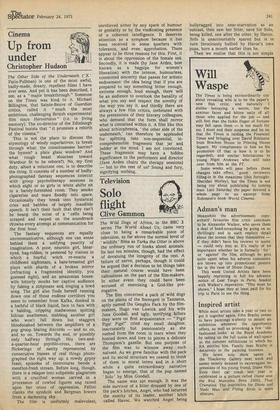Cinema
Up from under
Christopher Hudson
The Other Side of the Underneath (' X ' Paris-Pullman) is one of the most awful, badly-made, dreary, repellent films I have ever seen. And yet it has been described, I see, as a "major breakthrough." Someone on the Times was kind to it. Michael Billington, that Sainte-Beuve of Guardian critics, called it " much the most ambitious, challenging British experimental film since Herostratus " (i.e. in living memory). The co-director of the Edinburgh Festival insists that "it promises a rebirth of the cinema."
This is not the place to discuss the etymology of windy superlatives; (a break through what: the consciousness barrier? the hymen? a plate glass window? And what rough beast slouches toward Wardour St to be reborn?). No, my first duty, albeit a reluctant one, is to describe the thing. It consists of a number of badlyphotographed fantasy sequences intercut with group psychotherapy sessions in which eight or so girls in white shifts sit in a barely-furnished room. They smoke cigarettes and stare fixedly into space. Occasionally they break into hysterical cries and babbles of largely inaudible speech. It isn't their fault that they can't be heard: the noise of a ' cello being scraped and rasped on the soundtrack drowns every attempt at communication for the first hour.
The fantasy sequences are equally uncommunicative, although one can sense behind them a unifying paucity of imagination. A poor, neurotic girl, bleareyed, hag-ridden, is pestered by visions in which a fearful witch re-enacts a childhood nightmare, a bare-breasted girl plays with shards of a broken mirror (refracting a fragmented identity, you guessed right), and an amazonian housewife bitterly mocks her captive audience by faking a striptease and singing a lewd song. The girl also finds herself running down one of those endless corridors you seem to remember from Kafka, dunked in a bathful of black liquid, face to face with a balding, crippled madwoman spitting bilious anathemas, stabbing another girl who won't fall down but staggers bloodsoaked between the amplifiers of a pop group blaring discords — and so on. and so on. Towards the end, or possibly only halfway through this two-and a-quarter-hour psychlo-cross, there are flickerings of sanity represented by consecutive frames of real things photo graphed the right way up: a rowdy gypsy feast; episodes of intercourse beside a menthol-fresh stream. Before long, though, there is a relapse into solipsistic plagiarism with a crucified woman carried in a procession of cowled figures and raised upon her cross of oppression. Fellini clanks the symbols and Bergman lowers from a darkening sky.
The film is uniformly malevolent, unrelieved either by any spark of humour or geniality or by the vindicating presence of a coherent intelligence. It deserves attention as a symptom because it has been received in some quarters with tolerance, and even approbation. There appear to be three reasons for this. First, it is about the oppression of the female sex. Secondly, it is made (by Jane Arden, best known as a bagpipe for women's liberation) with the intense, humourless, committed sincerity that passes for artistic endowment: the idea being that if you are prepared to say something bitter enough, extreme enough, loud enough, there will be an audience to overlook the banality of what you say and respect the novelty of the way you say it. and thirdly there are always a few film critics, inebriated with the pretensions of their literary colleagues, who demand that the form shall mirror what is contained within it. A film like this about schizophrenia, 'the other side of the underneath,' can therefore be applauded for splitting into non-sequential, incomprehensible fragments that jar and judder at the mind. I am not convinced. These fragments may have a hidden significance to the performers and director (Jane Arden chairs the therapy sessions) — but to the rest of us? Sound and fury, signifying nothing.


































 Previous page
Previous page